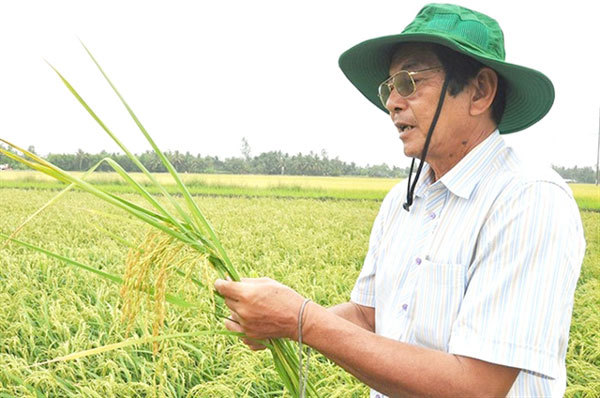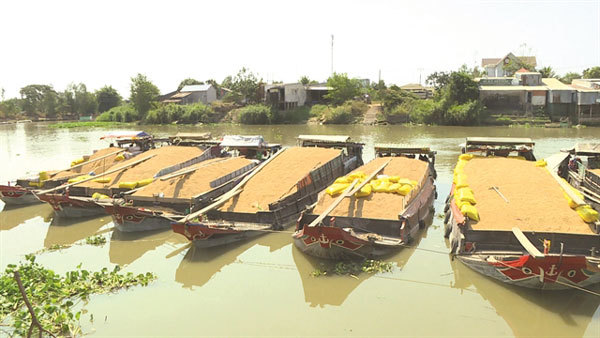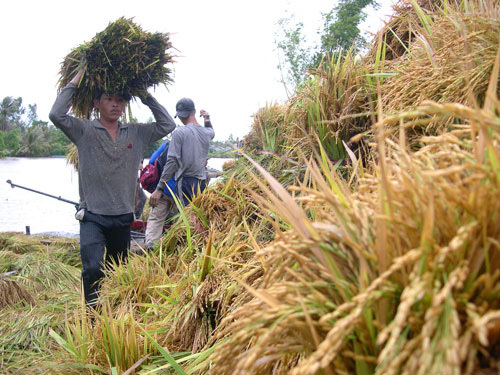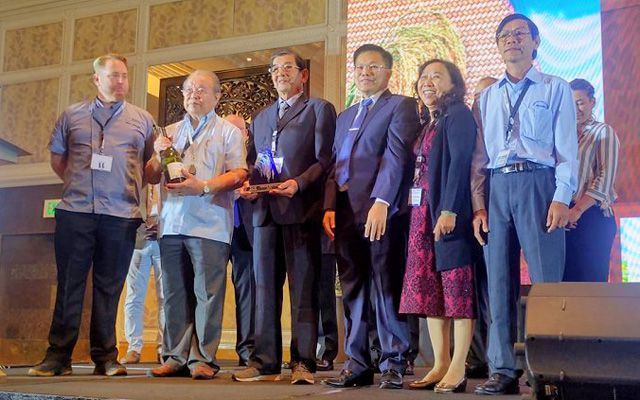 |
| Ho Quang Cua, who invented the world’s best rice strain, ST25, checks his field in Soc Trang Province. Photo source nongnghiep.vn |
That might be about to change: Its ST25 fragrant rice has been recognised as the world’s best. Xuan Huong reports.
I was one of the few people to receive a photo of the 2019 World’s Best Rice award from agricultural engineer Ho Quang Cua, whose ST25 strain won it in Manila.
The photo is beautifully framed in glass with the words “with compliments” written in red.
Cua, a deputy director of the Soc Trang Province Department of Agriculture and Rural Development, worked diligently for more than two decades with his associates Dr Tran Tan Phuong and engineer Nguyen Thi Thu Huong to develop the new strain.
He explains how it all began: “More than 20 years ago Thailand announced it successfully cross-bred two strains of fragrant rice [Thai Hom Mali and Pathum Thani].
“I kept asking myself why we could not do what they have achieved. So I thought of developing Vietnamese fragrant varieties, and a team of researchers was formed in Soc Trang.”
In 1998 the team unveiled ST1, the first of the ST aromatic rice strains, with the name representing the Mekong Delta province of Soc Trang (hence the abbreviation ST).
And since then the team has researched to produce a number of excellent strains of ST fragrant rice, Cua says.
“ST25 is a high-yield rice variety that yields two or three crops per year, can adapt to the difficult conditions brought about by climate change and grows well in brackish water and coastal farms,” he explains.
With its long grain, beautiful white appearance, and especially fragrant scent, thanks to a mixture of the aromas of the pandan leaf of the south and young rice of the north, ST 25 surpassed varieties from countries like Thailand and Cambodia to win the top prize at the World’s Best Rice contest, the first time a Vietnamese entry has won it.
The closest they had come before was in 2017 when ST24, a predecessor of ST25, won the third prize when the competition was held in Macau.
Behind this humongous success has been a very difficult and challenging journey, especially hurdles caused by technical setbacks, Cua reminisces.
Need to raise profile
 |
| A rice field ready for harvest in the Dong Thap Muoi region. VNA/VNS Photo Le Minh |
Rice has long been a strategic crop for Vietnam’s food security. From being a country that suffered rice shortages, it started exporting the grain in 1989, and has been one of the world’s largest producers and exporters for years now.
Vietnam grows around 26 million tonnes a year, of which it exports around six million tonnes.
Though the country exports its grain to over 100 countries and territories, consumers around the world do not know about its products, and its rice usually fetches lower prices than Thai and Cambodian varieties because of the absence of an appealing national brand.
According to the Vietnam Food Association, after mainly exporting low-quality rice for a long time, the country saw demand for its fragrant rice pick up strongly, with fragrant and other high-quality varieties now accounting for more than half of all exports.
But the prices they fetch remain very low, with the highest at only US$750-800 per tonne, while Thai rice of similar quality gets $1,100 - 1,200, the association says.
“Vietnamese rice is not inferior to that of its competitors in terms of quality, but inferior in terms of reputation," says Pham Thai Binh, general director of Trung An Hi-tech Farming JSC in Can Tho.
“Thailand and Cambodia have done very well in building brands for their rice, making global consumers have confidence in their quality. So their rice gets better prices," Binh says.
“Vietnamese rice has high quality but has not impressed global consumers. So its prices are usually low compared to other countries.
“Thus, though we have switched to exporting more high-quality rice, the value earned from exports has not changed much compared to the period when we mainly exported ordinary white rice at lower values.”
But this angst is undoubtedly something every country goes through as it seeks to move up the value chain.
To get the top, however, requires acquiring greater prestige in global markets, and this means developing brands for Vietnamese rice.
Some companies have started to build their own brands and export to niche markets at very good prices, but their scale remains very small.
Having a national brand name is an idea whose time has well and truly come.
Capitalising on world’s best
The Government unveiled a scheme in 2015 to develop a Vietnamese rice brand, but its results have so far been patchy.
Prof Vo Tong Xuan, rector of the Nam Can Tho University and a renowned agronomist, says ST25 has provided Vietnam a golden opportunity to build a brand name for its rice.
“It is time for the Government to immediately do the following three things: drastically restructure rice production towards chain-based production and develop large growing areas that produce the same rice variety, minimise the use of insecticides to cut costs and produce more nice, delicious and safe rice and shift the industry’s focus from quantity to quality and from being supply-driven to market-driven.”
Le Van Banh, former head of the Mekong Delta Rice Institute, says Vietnam has many good rice varieties, some better than the high-quality varieties of its rivals.
However, quality suffers because Vietnamese farmers grow three or four crops a year, whereas in Thailand they do not grow more than two crops, Banh says.
Thailand has loyal markets since global consumers have confidence in its quality, and so its exports fetch better prices, he explains.
“It is necessary to develop rice brands, including national brands, local brands and companies’ brands. And when we have brands, we have to protect them. It is also necessary to offer high-quality products to win consumers’ trust.”
Do Ha Nam, vice chairman of the Vietnam Food Association and chairman of Intimex Group, says farmers and businesses need to revamp production techniques and improve hygiene and food safety management and post-harvest preservation to surmount the increasing technical barriers set by import markets.
It is necessary for Vietnam to develop rice brands and enhance marketing programmes to acquaint global consumers with its grains and their quality, he says.
“Every brand should be built on a high-quality foundation and recognised and remembered by consumers because of its tightly controlled quality.”
There have been many voices calling on the Government to throw the book at those who sell counterfeit rice varieties to prevent this practice and motivate researchers to keep producing new, valuable strains.
Many also say brand building should begin at home.
The domestic market, which has nearly 100 million people who eat rice every day, after all accounts for a full 80 per cent of rice production.
Moreover, with rising incomes, consumers are willing to pay higher prices for branded or high-quality rice, and so building brands should not only be for international markets, they point out.
The domestic market should be the place to test quality, brands and origins before expanding globally, they add.
This will surely be aided by the fact that since winning the World's Best Rice competition, demand for ST25 and its renown have skyrocketed in Vietnam.
Phan Thanh Hieu, director of Phuong Nam Company, the distributor of ST rice for the last six years, says the ST24 and 25 varieties are selling very well. “We don’t have enough rice to sell.”
Focus on market demand
 |
| Boats carrying paddy waiting for uploading and processing. VNS Photo Ngoc Diep |
There is a growing demand for high-grade rice in the global market, offering Vietnam a great opportunity, vice chairman Nam says.
Vietnamese fragrant rice is very popular with Hong Kong consumers due to its lovely aroma and delicious taste, and so exporters have a great opportunity here, he says.
He wants the agricultural sector to choose high-quality varieties that are in demand in many markets, such as jasmine rice, and grow them.
Nguyen Nhu Cuong, head of the Crop Production Department, says: “The demand in the world market is diverse. Africa, the Philippines and Indonesia, for instance, prefer medium-quality. So we need to have an area to grow medium-quality rice to supply to these markets.
“At the same time we need to identify varieties to supply to fastidious high-end markets such as Europe.
“We have exported jasmine and japonica rice to high-end markets at rather high prices. ST24 and ST25 have met the requirements of demanding markets. Yet we have limitations in exporting premium rice to fastidious markets. Official agencies and businesses need to identify and address them.
“Consumers around the world are increasingly paying attention to the origin, production processes, quality standards, and nutritional content of rice; they no longer consider rice a mere food item. Therefore, there must be greater focus on traceability and hygiene and food safety."
Many free trade agreements the country has signed provide opportunities for its farm produce to enter large markets without tariffs, but their exports can only be sustained if Vietnamese products meet quality standards and consumers’ expectations.
“The Ministry of Agriculture and Rural Development and Soc Trang authority have collaborated with our team to expand the ST25 rice variety cultivation area,” Cua adds. VNS

The hard lot of Vietnam’s rice
Vietnam’s rice export price is always low compared with other countries because consumer confidence in Vietnam’s rice quality is not high, experts say.

Fake world’s best rice products flooding in the market
Products which claim to feature the ST25 rice strain which was crowned the World's Best Rice at a recent contest have flooded in the Vietnamese market.
 Vietnam may be one of the world’s top rice exporters, but its reputation as a low-quality producer and lack of an appealing national brand has ensured its exports do not fetch high prices.
Vietnam may be one of the world’s top rice exporters, but its reputation as a low-quality producer and lack of an appealing national brand has ensured its exports do not fetch high prices.